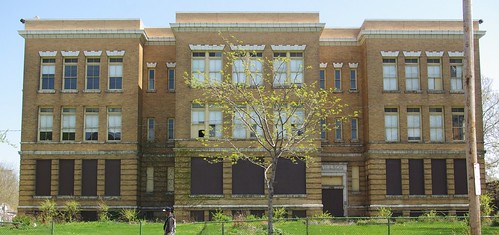
A little while ago, I published a photo essay illustrating the 25 schools that the Cleveland Metropolitan School District (CMSD)wants to demolish. Five of these schools will be rebuilt on the existing sites. But the other twenty will just become vacant land, which the CMSD believes will be more attractive to buyers. I would hope we would have learned from our downtown that when land is vacated to become more attractive to developers, it often just stays vacant.
Some of the buildings are deep in residential neighborhoods. For these, reuse proposals must take into account their surroundings - perhaps they'd be appropriate for artist lofts or light commercial space, as has been done with the Hodge School and Murray Hill School.
Some, however, are on major commercial arteries, such as the Willson School, shown above, on East 55th Street. Some that fit this description are South High, on Broadway; East High, on Superior at East 79th; Miles, on Miles Avenue; and Mount Pleasant, on Union. These buildings might be repurposed as commercial structures.
How can this be done, if these buildings are too expensive to renovate as public schools? Quite simply, the standards required for commercial structures are much lower than those required of schools.
We're tearing down a lot of buildings right now. Some are in such condition that they ought to be torn down. Many of these still have lots of great architectural detail that could be saved - but it isn't being saved - it's being bulldozed and destroyed.
Architectural salvage, on the most basic level, required little initial capital. There's a market for the doors, trim, and other interior fixtures in these buildings. Yes, there are some stores on Lorain Avenue, on the west side, that deal with such materials. Their prices tend to be expensive - a couple hundred dollars for an interior door - prices that are outside the reach of most people. There's also the Habitat for Humanity ReStore, but they don't tend to have that much material in stock and it, too, is on the west side.
We might learn a lot from Buffalo ReUse, a salvage operation in Buffalo, New York. I've visited their salvage yard and followed the great stuff that continues to come through their doors on Flickr. At any given time, they have two or three times as much material in stock as in all the stores in Cleveland put together.
Their prices tend to be close to what a big box store charges for the cheapest version of a similar item - solid wood interior doors sell for $25-50, for instance. At prices like this, the material moves quickly. As a result, average people are able to maintain and repair their homes, keeping up the aesthetic and historic quality of their neighborhoods.
A program like this would be an excellent use for one of the schools that is to be closed. A structure like of one of these schools would allow for organization of materials by type and size, and, as many of the schools in question are on the east side, it would be closer to a largely unserved market.
In the current fiscal situation, it doesn't make sense to keep destroying building materials for which there exists a strong market. If we're not going to fix up these houses or schools, the least we can do is to repurpose their materials elsewhere.




First, the Watterson-Lake school right near me is a building that should not be lost. If it were, I'd LOVE to be able to salvage the wrought iron fencing and many other things. If there is anything I can do to help create a marketplace for items salvaged.
ReplyDeleteI haven't been to the Buffalo store, but it looks like they are trying to do a good thing. Recycling even the lumber out the old houses is encouraging. The wood is much better than something you'd find at Home Depot or rather I'm sure almost everything they sell is better than Home Depot.
ReplyDeleteI also like the idea of adaptive reuse. Those schools could be: apartments, community centers, temporary stores( like bizarre bazaar), really anything.
My mother was born a few blocks from Willson school in 1925 and still
ReplyDeletelives in her childhood home. She attended Stanard school near east 55th and Willson school. She says both schools had lovely interiors. How many schools nowadays would be described as beautiful and inspiring? Stanard has already been demolished. My family would be so happy to see Willson repurposed in some way.
Thank you for your blog.I really enjoy reading it. I live in New York now, but my heart is still in Cleveland .
I have been waiting for this to happen in Cleveland for a long time. We are one of the few major cities that does not do this recycling of valuable architecture. What do we need to do to make this happen in Cleveland?
ReplyDeleteWhat it would take, more than anything else, is someone who is willing to take the time and make it their issue.
ReplyDeleteThis comment has been removed by the author.
ReplyDeleteHI
ReplyDeleteI DO DEMOLITION WORK, REMOVING HAZMATS FROM SCHOOLS. U NEED TO TALK TO THE DEMOLITION CONTRACTORS AS THEY SELL MOST EVERYTHING. THE SCHOOLS SALVAGE WHAT THEY WANT BUT DONT CARE CUZ ITS TAX MONEY ANYWAY. WITH NEW LEED GREEN GUIDELINES THEY GET CREDIT FOR RECYCLING CONCRETE, SOD, MULCHING TREES, REMOVING HAZMATS, RECYCLE ASPHAULT, CEILING TILES LIGHT FIXTURES, BUT NOT NOT USUALLY TO ANTIQUE TYPE STORES. MOSTLY BULK ITEMS. TALK TO DEMOLITION GUYS FOR STONE AND DOORS AND CARVINGS, WOOD ETC.